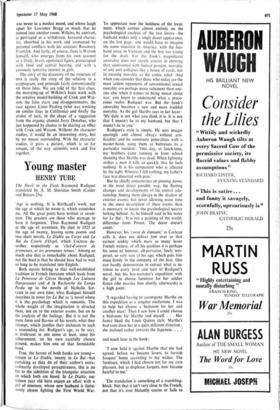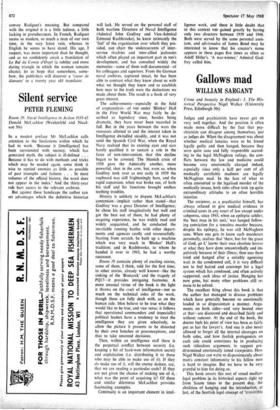Young master
HENRY TUBE
The Devil in the Flesh Raymond Radiguet translated by A. M. Sheridan Smith (Calder and Boyars 25s) `Age is nothing. It is Rimbaud's work, not the age at which he wrote it, which astonishes me. All the great poets have written at seven- teen. The greatest are those who manage to have it forgotten.' Thus Raymond Radiguet at the age of seventeen. He died in 1923 at the age of twenty, leaving some poems and two short novels, Le Diable au Corps and Le Bal du Comte d'Orgel, which Cocteau de- scribes respectively as `chef-d'oeuvre de promesses, et les promesses tenues.' Among so much else that is remarkable about Radiguet, not the least is that he should have had to wait so long to be translated into English.
Both novels belong to that well-established tradition in French literature which leads from La Princesse de Cleves through Les Liaisons Dangereuses and A la Recherche du Temps Perdu up to the novels of Nathalie Sar- raute in our own time; what Radiguet himself describes in notes for Le Bal as 'a novel where it is the psychology which is romantic. The whole weight of the imagination is directed there, not on to the exterior events, but on to the analysis of the feelings.' But it is not the mere form and flavour of his novels, what they attempt, which justifies their inclusion in such a resounding list. Radiguet's age, as he says, is irrelevant in one sense at least, since his achievement, on his 'own carefully chosen ground, makes him one of that formidable band.
True, the heroes of both books are young— sixteen in Le Diable, twenty in Le Bal—but partaking as they do of their author's extra- ordinarily developed perceptiveness, this is no bar to the subtleties of the triangular situation on which both are based. In Le Diable, our sixteen year old hero enjoys an affair with a girl of nineteen, whose new husband is fortu- nately absent fighting the First World War. To appreciate now the boldness of the treat- ment, which centres almost entirely on the psychological analysis of the two lovers—the husband makes only a single direct appearance, on the last page—one would have to imagine the same situation in America. with the hus- band away in Vietnam and the boy too young for the draft. For the book's magnificent amorality does not simply consist in showing that, confronted with human passion, morality of any sort collapses like a house of cards, but in treating morality as the comic relief. And when you consider that those who today are the most ardent opponents of conventional sexual morality are perhaps more vehement than any- one else when it comes to being moral about war, you begin to understand what a preco- cious realist Radiguet was. But the book's amorality becomes a new and more truthful morality. As the girl Marthe says to her lover: `My duty is not what you think it is. It is not that I mustn't lie to my husband, but that I mustn't lie to you.'
Radiguet's style is simple. He uses images sparingly and almost always without arti- ficiality, and he constructs generalities with a master-hand, using them as buttresses to a particular incident: 'One day, at lunch-time, my brothers came running in from school shouting that Marthe was dead. When lightning strikes a man it kills so quickly that he feels nothing. It is his companion who is affected by the sight. Whereas I felt nothing, my father's face was distorted with pain.'
But he chiefly concentrates on pinning down, in the most direct possible way, the fleeting changes and developments of his central rela- tionship, finding them always in the shadow of exterior events, but never allowing more time to the mere description of these events than is necessary to locate the psychological quarry lurking behind. As he himself said in his notes for Le Bal: 'It is not a painting of the world; difference from Proust. The decor doesn't count.'
However, his 'coeur de diamant,' as Cocteau calls it, does not deliver him over to that earnest aridity which mars so many lesser French writers; of all his qualities it is perhaps his sense of humour, all-pervasive, finely tem- pered, so very rare at his age, which puts him most firmly in the company of the best. One can hardly demonstrate in extract what is in- trinsic to every twist and turn of Radiguet's novel, but his boy-narrator's expedition with the girl to choose furniture for her soldier fiancé (she marries him shortly afterwards) is a high point: `I regarded having to accompany Marthe on this expedition as a singular misfortune. I was to help her choose a bedroom for her and another man! Then I saw how I could choose a bedroom for Marthe and myself. . . . Her fiancé liked the Louis Quinze style. Marthe's bad taste drew her in-a quite different direction: she inclined rather towards the Japanese. . .
and much later in the book: `I now held it against Marthe that she had agreed, before we became lovers, to furnish Jacques' home according to my wishes. The furniture, which I had chosen not for my own pleasure, but to displease Jacques, now became hateful to me.'
The translation is something of a stumbling- block. Not that it isn't very close to the French, not that it's ever blatantly coarse or fails to convey Radiguet's meaning. But compared with the original it is a little tedious, a little lacking in protuberances. In French, Radiguet seems so modern, so much a man of our own time, in the very latest vein, whereas in English he seems to have dated. His age, I suspect, was more important than he thought, and as we confidently await a translation of Le Bal du Comte d'Orgel (a subtler and more daring triangle in which the woman remains chaste), let us hope that somewhere, some- how, the publishers will discover a `coeur de diamant' in a twenty year old translator.







































 Previous page
Previous page